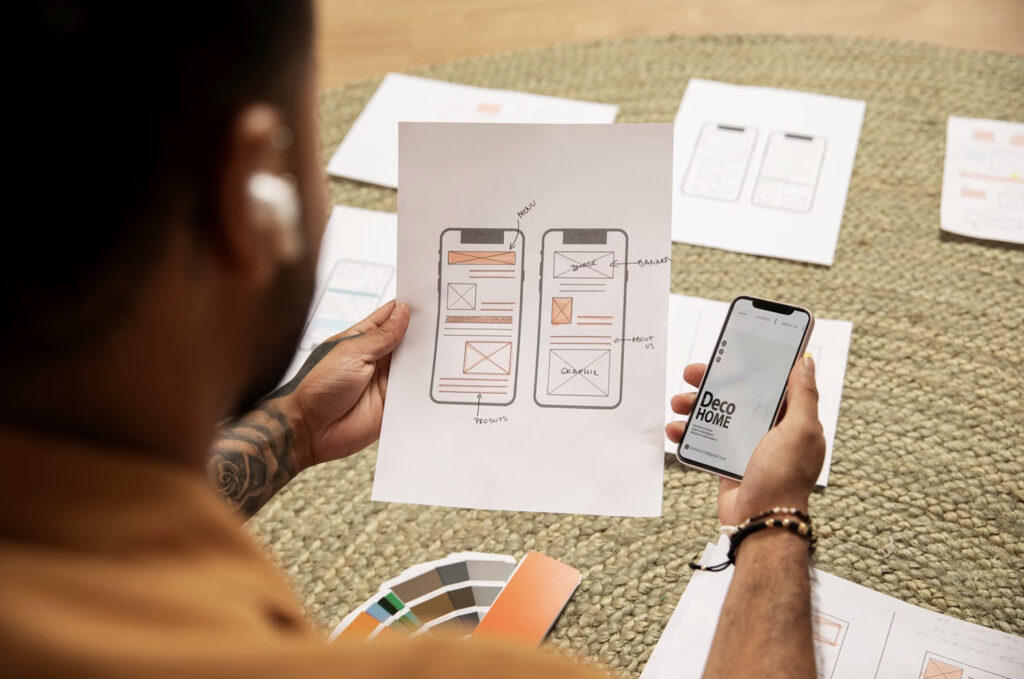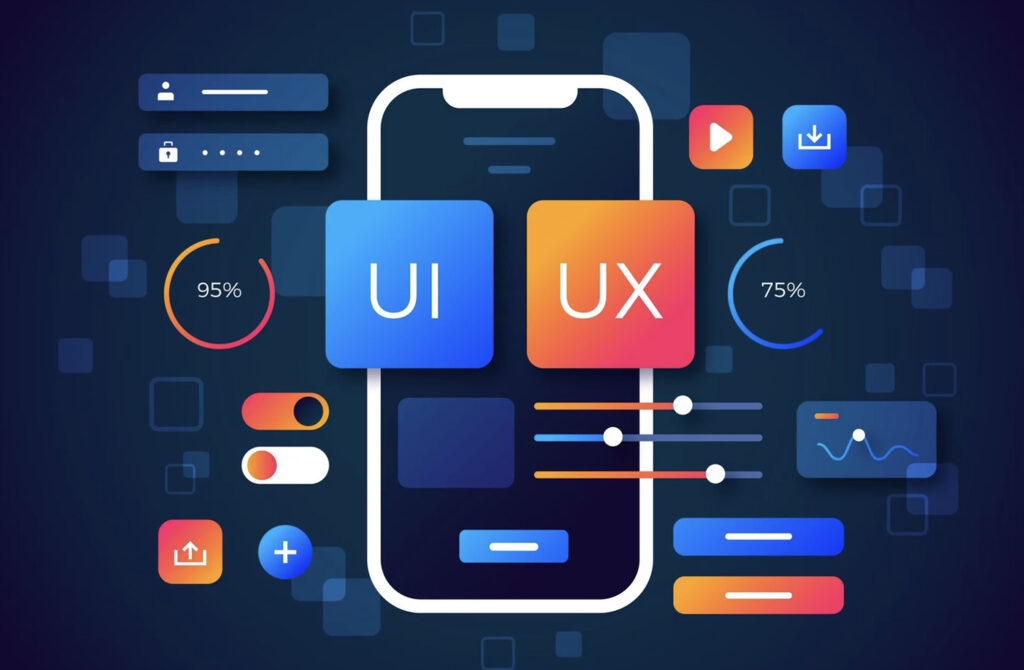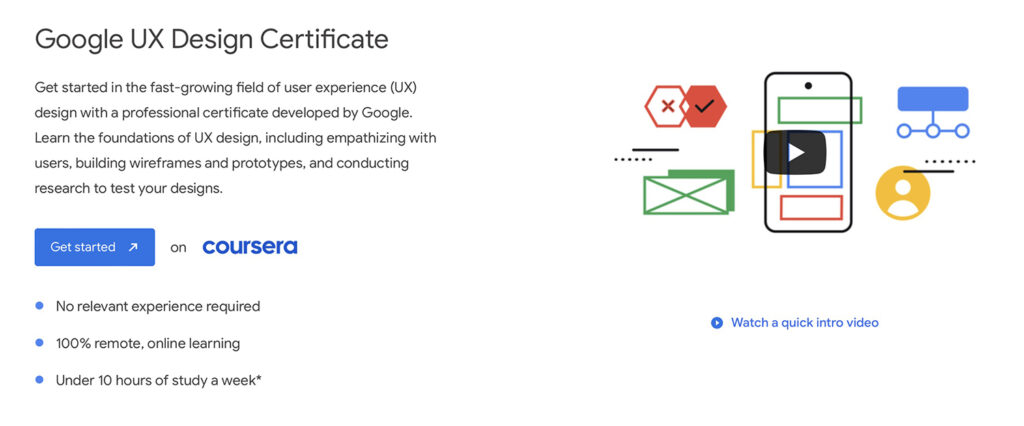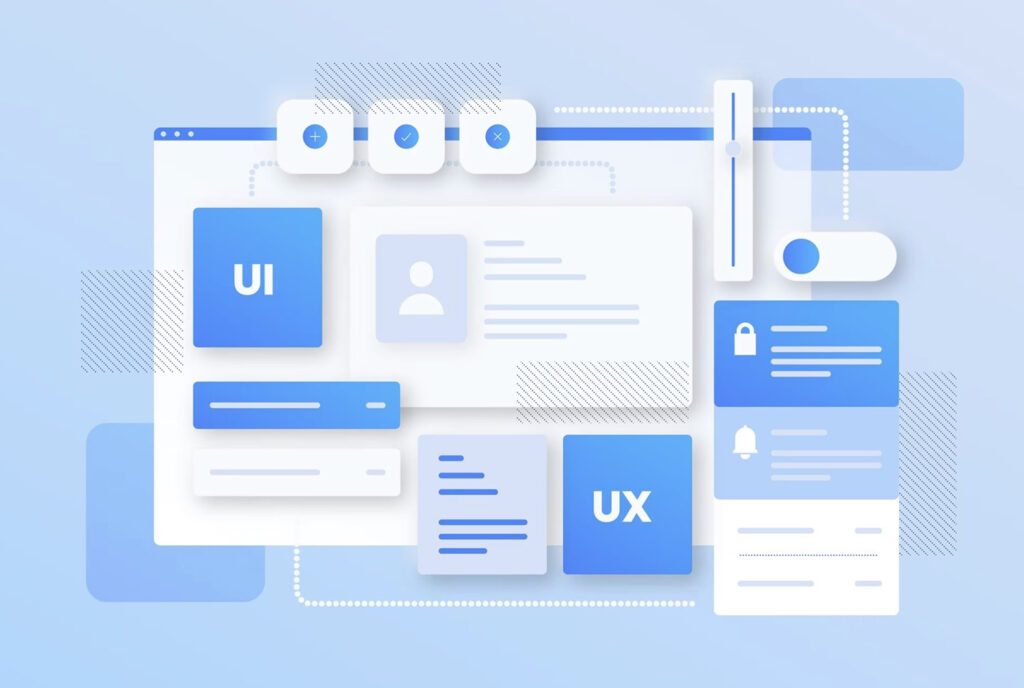Updated: Jun 26, 2023 By: Dessign Team

Understanding UI and UX Design
User Interface (UI) and User Experience (UX) design are two critical components of app development. UI design mainly focuses on how an app looks, whereas UX design deals with how an app feels. UI primarily deals with visual elements, such as iconography, typography and color schemes.
UX is about making sure that the app is functional, and the user can navigate through it with ease. It’s important to understand UI and UX design to create an optimal user experience and engage users effectively.
UI and UX design are inseparable and equally crucial. A well-designed UI will serve little purpose if the UX is poor. Similarly, an excellent UX would be lost without a good UI design. Both are the backbone of an app and need to work hand in hand to create a successful product. An intuitive UI allows users to interact seamlessly with the app and encourages them to keep using it. An outstanding UX ensures that users have an enjoyable and satisfactory experience while using the app.
The primary goal of UI and UX design is to make an app easy to use, visually appealing, and engaging. A well-designed app will make the user feel comfortable and confident while navigating through it. The most successful apps have achieved this by having an efficient and user-friendly interface, which ultimately leads to increased user retention. Understanding UI and UX design is crucial to an app’s success.
According to a study in Forbes magazine, 88% of users will not return to a website if the user experience is poor. This highlights how crucial it is to prioritize UI and UX design in app development. Ensuring a positive user experience should be the primary focus of any app developer, and investing in quality UI and UX design can help achieve that goal.
UI and UX design: because if users don’t understand it, they’ll blame you instead of their own lack of tech skills.
Five Facts About UI vs. UX Design:
✅ UI refers to the visual elements, while UX refers to the overall interaction a user has with a product.
✅ Both UI and UX designers play key roles in the product development lifecycle.
✅ UI designers focus on creating visually appealing and easy-to-navigate digital products.
✅ UX designers focus on creating functional, accessible, and enjoyable product experiences for users.
✅ Degrees in computer science, design, or human-computer interaction are often pursued by UX and UI designers, but experience and skills are also highly valued.
The Difference Between UI and UX Design

As a designer, it’s crucial to understand the difference between UI and UX design. The field of design has evolved significantly over the years, and with the growing demand for digital products, the nuances between UI and UX design have become even more essential.
So, in this segment, we’ll delve into the idea of UI versus UX design, exploring the fundamental differences between the two disciplines. We’ll begin by discussing UI design, examining its definition and key components. Then, we’ll move on to UX design and explore the critical factors that distinguish it from UI design.
What is UI Design?

UI design, also known as user interface design, is the process of designing the visual elements of an application that users interact with. It deals with creating layouts, color schemes, typography, and other graphic elements to ensure a great user experience. The primary goal of UI design is to make the user’s interaction with an application seamless and efficient.
The purpose of UI design is to create a visually appealing interface that enables easy navigation and enhances usability. It involves understanding the users’ preferences in terms of layout, typography, and other visual elements. The focus is on creating intuitive designs that guide the user through their journey in using an application. This not only improves the overall user experience but also ensures increased engagement.
A good UI designer should possess excellent aesthetic skills and have extensive knowledge of graphic design principles. They should be able to create patterns and styles that are consistent throughout an app or website. Additionally, they should have a strong understanding of web development technologies such as HTML, CSS, and Javascript.
To excel in UI design, it’s crucial to stay up-to-date with advances in technology to develop new ways of enhancing interfaces. Participating in online communities related to design can help UI designers keep up with emerging trends and techniques.
In summary, UI design plays a critical role in designing applications that users find attractive and easy to use. By incorporating engaging visuals while keeping functionality at the core, these designers conceptualize digital experiences that pique users’ interest. Creating a seamless user experience is the name of the game for UX design.
What is UX Design?

User Experience (UX) design refers to the process of crafting digital products that effectively allow users to interact with them. It involves creating user-centered designs that are intuitive, accessible, and pleasing to navigate. UX design combines various elements such as usability, aesthetics, functionality, and interaction to create a positive user experience.
UX design strives to meet the needs of end-users by ensuring that digital products solve their problems. It involves carrying out research, testing ideas, observing behavior patterns, and defining information structures in a way that is both clear and meaningful.
Moreover, UX designers work towards improving customer satisfaction by making applications or websites easy to use and understand. They create wireframes, prototypes, and mockups that focus on workflows from the user’s point of view and ensure that their interactions with digital products are effortless.
One could say that UX design is the invisible force behind many successful digital products. A well-designed product provides an enjoyable experience not only for meeting the desired outcome but also for the journey itself. For example, Apple’s iPhone is known for its intuitive design which delights users worldwide – making it a monumental success story for UX designers around the world.
UI designers focus on the visual elements, while UX designers focus on creating a seamless user experience – together, they’re like peanut butter and jelly.
Roles and Responsibilities of UI and UX Designers

As a designer, I understand the importance of creating seamless user experiences through effective UI and UX design. When it comes to developing interfaces for websites or applications, it’s essential to distinguish between the roles and responsibilities of UI and UX designers.
In this segment, we’ll explore the unique contributions of UX designers in focusing on user experience and interface flow, while UI designers create the visual design elements to bring them to life. By examining the distinct roles and responsibilities of each design function, we can gain a better understanding of how these disciplines work together to create effective digital experiences.
UX Designer: Focusing on User Experience
A UX designer’s primary responsibility is to focus on creating an experience that pleases and satisfies users in every possible way. They ensure that a website or application is easy to navigate and understand while also being visually appealing.
UX designers use testing methods like focus groups, surveys, and user feedback to create their products with user satisfaction in mind. Good communication skills are essential for UX designers since they constantly work with other departments to ensure that all elements of a product work together harmoniously.
UI designers paint the canvas of user experience with visual elements that captivate and impress.
UI Designer: Creating the Visual Elements
The job of a UI designer is to create the visual elements of a product or service. They focus on designing the interface through which users interact with digital products. The UI designer uses their creative skills, knowledge of design software, and understanding of user behavior to develop an effective and visually appealing interface.
The goal of a UI designer is to create an intuitive and user-friendly layout that guides users towards their intended tasks. They ensure consistency in design elements such as colors, typography, icons, and graphics throughout the product. A UI designer collaborates with other team members such as UX designers, developers, and project managers to ensure smooth integration.
UI designers need to have strong technical skills such as proficiency in design software like Photoshop or Sketch, knowledge of web development tools like HTML/CSS, and have a good understanding of coding languages like JavaScript. They should also possess communication skills enabling them to convey the importance of design decisions clearly.
A suggested starting point for aspiring UI designers is gaining experience through internships or freelance work building their portfolios. Continuous learning and keeping up with industry trends can enhance their skill sets.
In summary, a career in UI design involves developing creative visual solutions that meet both user’s needs and business goals while adhering to technical constraints. Therefore, combining technical skills with creativity makes for a successful UI designer: creating the visual elements for any digital product or service! UI and UX Designers must have a creative eye, attention to detail, and a passion for enhancing user experience.
Qualifications and Skills Required for UI and UX Designers

As someone who is exploring a career in design, I am always curious about the qualifications and skills required to succeed in the field of UI and UX design. To become a competent UI/UX designer, it is important to understand the various education and training options available.
In addition, each specialty comes with specific job requirements, which differ based on whether you are pursuing a career in UX design or UI design. So, let’s dive into the world of UI and UX design and explore the education and training options, and job requirements for aspiring designers.
Education and Training

To succeed as a UI or UX designer, a solid foundation in education and training is necessary. Candidates must gain the relevant skills and knowledge to design intuitive user interfaces and engaging user experiences. This involves acquiring an understanding of different design principles while staying up-to-date with industry changes.
UI and UX designers require diverse skill sets that can be acquired through education and training programs such as certificates, diplomas, degrees, or short courses. UI design entails learning visual design principles such as color theory, typography, layout, and iconography. On the other hand, UX designers need to master interactions and information architecture.
It is imperative that candidates research the type of education or training they opt for based on their career goals. They should also consider salient factors such as cost, instructor quality, course content relevance, duration, location, and availability of practical training.
Having acquired this education and training helps improve employability by developing a portfolio of work that showcases their skills. By learning from leading professionals in the field as well as applying these skills in real-world projects offers an excellent opportunity to kickstart a career in UI or UX design effectively.
Step up your UX game with these essential job requirements that separate the amateurs from the pros:
- Solid knowledge of usability standards.
- Proficiency in design software such as Sketch, Photoshop, Illustrator, Figma, or Adobe XD.
- Strong understanding of UI/UX design principles.
- Familiarity with front-end coding languages such as HTML, CSS, and JavaScript.
- Ability to create wireframes, prototypes, and mockups.
- Excellent communication and collaboration skills with team members and clients.
UX Design Job Requirements
UX designers need to have a set of specific skills and qualifications to meet the UX design job requirements. A strong understanding of user-centered design principles, interaction design, research methodology, and usability testing is essential. In addition, they should be proficient in wireframing tools such as Sketch or Adobe XD, prototyping software like Axure or Framer, knowledge of web-based technologies and programming languages.
The qualifications for UX designers include a bachelor’s degree in computer science, graphic design, human-computer interaction (HCI), or other relevant fields such as psychology or sociology. A Master’s Degree is an advantage for senior UX designer roles. They should also possess excellent communication and interpersonal skills to work with cross-functional teams alongside strong analytical and creative problem-solving abilities.
UX designers must be knowledgeable about user research processes and methods like creating personas, storyboards user journey maps. They must also be able to conduct iterative usability tests at various design stages and analyze the results thereof.
Experience in end-to-end product design cycle, designing adaptive user interfaces for different platforms such as desktops, mobile devices, wearables is needed for the role. They should stay updated on current industry trends in technology while also discovering new techniques to improve their design process.
According to history, the role of UX Designer emerged when companies realized that apart from UI Designers working independently there was a lack of Focus on User-Centered Design Process leading to insufficient user satisfaction. UX Designers are relatively newer compared to more traditional ones like graphic designers.
Want to be a UI Designer? Better brush up on your coding skills!
UI Design Job Requirements
UI design job requirements focus on the skills and qualifications needed for creating visual elements in a user interface. These professionals must have expertise in graphic design, typography, color theory, and branding. They should be proficient in using design software like Photoshop, Sketch, or Illustrator. They must possess the ability to work collaboratively with development teams to ensure that their designs are feasible and functional.
UI designers must stay updated on emerging trends and technologies in the UI/UX industry. They need to have excellent communication skills to articulate their ideas and receive feedback from stakeholders. Additionally, they need to demonstrate excellent time-management abilities and meet deadlines for completing projects.
One crucial aspect of UI design is accessibility compliance. It is necessary to conform to WCAG 2.1 guidelines related to accessibility. UI designers must ensure that every user can access their products regardless of any disabilities or impairments they may have.
The history of UI design can be traced back to the rise of graphical user interfaces (GUIs) in the 1970s when computer users demanded more intuitive interfaces that Microsoft Windows popularized in mainstream computing hardware in 1985 which made significant changes by introducing a point-and-click operating environment that required new design standards for what has now evolved into modern-day graphical user interfaces (GUI).
Making the choice between UI and UX design careers is like choosing between pizza and tacos – both are delicious, but which one suits your taste buds?
Choosing Between UI and UX Design Careers

I recently came across a dilemma while choosing a career in design: whether to focus on UI or UX design. So, I did some research and found some useful information that might help make this decision easier for aspiring designers.
First, let’s talk about the average salary and job demand for both fields. Next, we’ll look into the factors you should considerwhile choosing a career and how to determine which design field is a better fit for your interests and skill-set.
Average Salary and Job Demand
Professionally speaking, understanding the demand and average salary for UI and UX designers is crucial. Below is a table that presents the average salary and job demand of both careers in the US.
| Job | Salary | Job Demand |
|---|---|---|
| UX Designer | $87,883 per year | High |
| UI Designer | $70,015 per year | Medium |
It should be noted that these figures are subject to change based on factors such as geographic location, industry experience, and company size. However, the data does suggest that there is a notable difference between the two salaries. UX designers generally earn more than UI designers due to their specialized focus on user research and testing.
In addition to salary differences, job demand also varies between the two roles. UX design has been identified as one of the fastest-growing fields with many job opportunities available worldwide. As companies increasingly prioritize user-centered design principles, they recognize the value of skilled UX professionals who can help them meet their business needs by improving their products’ functionality and user satisfaction.
Furthermore, it is essential to note that while salary and job demand are important considerations when selecting a career path, personal preference and skill set must also play a part in decision making.
“Choosing a career is like choosing a partner, it’s important to consider compatibility, salary, and job demand before committing to UI or UX design.”
I once met an accomplished UX designer who started out as a graphic designer but soon realized her passion for creating effective user experiences. She took courses in user research and analysis before landing her first entry-level position at a startup company. Over time she honed her skills through trial-and-error with various projects before building up an impressive portfolio of work that led to higher-paying positions at larger firms.
Factors to Consider when Choosing a Career
To choose a career, several crucial factors need consideration. Here are some critical aspects to consider when selecting a profession:
- The individual’s interests must align with the industry and role they intend to pursue
- Salary and job opportunities require thorough research through various sources
- Future growth in the industry and opportunity for advancement should be evaluated
- Work-Life balance and company culture play an important part in determining job satisfaction
- Evaluating skillsets to understand which career path aligns with your core skills.
Moreover, it’s essential to know that each person has different considerations during the career selection process. Therefore, thoroughly assessing personal lifestyle choices, abilities, and passions plays a vital part in making a well-informed decision.
A friend once shared how content he was after gaining clarity between his passion for UX design and UI design that led him to make an informed decision about his career path. It’s crucial to gather ample information before making any significant decisions.
Choosing between UI and UX design is like choosing between a flashy sports car and a comfortable SUV – it all depends on your personal driving style and career goals.
How to Determine if UI or UX Design is a Better Fit
To determine which design career, UI or UX design, suits better, it is essential to understand each role’s characteristics. For one, a UI designer creates a visual appeal for digital products, while the UX designer’s focus is on creating user experiences.
When making a choice between these two careers, consider skill set and interests. If one has an eye for detail and enjoys working with specific styles to create designs that are visually pleasing and intuitive for users, then learning towards UI design may be more appropriate. Otherwise, if one prefers research-based work that goes deep in understanding customer behavior and psychology, focusing on providing seamless experiences would be a more suitable option.
Pro Tip: Talking to professionals in the field can add valuable insights into their journey to determine whether it aligns with the aspirant’s perception of the design career.
Unleash your UX potential by discovering other exciting career paths within the industry.
Beyond UI and UX Design: Other Careers in UX
When it comes to careers in user experience design, many people think of UI and UX design roles exclusively. However, there’s a whole world of other career opportunities waiting to be explored. In this section, we’ll take a closer look at alternative UX design roles.
We’ll explore the responsibilities, requirements, and day-to-day work of different UX design positions, from content strategists to information architects. We’ll also provide guidance on how to determine which role might be best suited to your skills and interests, and how to make the transition into a new UX design career.
Exploring Other UX Design Roles
The UX industry offers various roles other than UI and UX Designers to explore. These roles include Information Architects, Interaction Designers, User Researchers, and Content Strategists. Each role requires specific skills tailored for creating effective user experiences.
Information Architects are responsible for organizing content into a clear and structured hierarchy that is easy to navigate, while Interaction Designers concentrate on the behavior of the interface elements. User researchers explore user needs and preferences through research methods such as interviews, surveys, and focus groups, while Content Strategists develop content plans that align with users’ goals.
Exploring other UX design roles allows individuals to find their unique fit in the UX industry based on their aptitude and interests. By cultivating new skills and taking additional coursework or certification courses in these areas, one can build a diverse portfolio that reveals expertise with different components of the UX ecosystem.
Pro Tip: Focusing on mastering at least two other UX specialties besides UI/UX design early in one’s career can lead to rapid professional growth and open up paths toward leadership positions down the road.
Unleash your creativity and find your niche in the diverse world of UX design roles.
Finding Your Fit in the UX Industry
Discovering Your Perfect Role in UX Design Industry
Understanding your interest is an essential step towards finding your fit in the UX industry. There are numerous roles outside of UI/UX design, and it’s crucial to understand the various responsibilities and skills needed in each. Once you know where your strengths lie, finding the right position will be much easier.
It is also important to consider what type of team you want to work with. Some prefer cohesive teams while others thrive in challenging situations and prefer working as a lone wolf. Understanding these details will help identify suitable companies or teams that could align with your values.
Suppose you find yourself stuck, feeling confused about how to approach other UX design roles beyond UI/UX designing. In that case, contacting industry professionals for mentorship opportunities can provide clarity on which area you should explore further.
Real Story:
After five years as a UX/UI designer, Jolene felt like she had hit a plateau and craved new challenges but couldn’t figure out which path was best. She reached out to some professionals who connected her with a digital transformation consultant role at an e-commerce company.
Two years in now, she realized that this diverse role broadened her skill-set through collaboration with different professionals throughout the organization and gave her new insights into the needs of users across industries.
Conclusion: Making a Career in UI and UX Design
UI and UX Design Career Prospects
The UI and UX Design industry is growing with digital advancement, and it is an excellent time to tap into the market. To kickstart a career in UI and UX Design, building a solid foundation in graphic design, coding, and user behavior analysis is necessary.
Still, continuous learning and developing an adaptive approach remain crucial in this constantly evolving market. With the skills and experience gained, finding a job as a UI or UX designer can open up many possibilities, from working in-house or freelancing to advancing into management roles.
To succeed in the UI and UX design industry, experts emphasize the need to hone skills while keeping up with the latest industry trends and advancements. Seeking mentorship programs, networking, developing a strong portfolio, and being open to learning are key ingredients in this career.
Moreover, UI and UX designers can work on various digital platforms, including mobile applications, website design, or digital marketing, providing a wide range of possible niches to explore and develop.
According to a recent survey by Creative Bloq, the average UI Designer earns $70,000 yearly, while the average UX Designer earns $88,000 annually. With the industry’s promising growth and notable earnings, the UI and UX design career is an attractive path to take.
Key Takeaway:
- UI and UX design are two different fields that are closely related. UI design involves designing the visual elements of a product, while UX design focuses on the overall user experience.
- Good UI design focuses on usability, simplicity, and aesthetics. In contrast, good UX design prioritizes user needs, goals, and emotions, and ensures that the product is easy and enjoyable to use.
- Both UI and UX designers require a combination of technical and soft skills, as well as an understanding of design principles and user behavior. It is important to choose a career path based on personal strengths and interests.
FAQs about Ui Vs. Ux Design
What is the difference between UI and UX design?
UI design refers to the visual elements that a user interacts with on a website, app, or other electronic device, such as screens, buttons, toggles, icons, and other graphical portions. UX design refers to the entire interaction a user has with a product, including how they feel about the interaction, and involves creating a product that is functional, accessible, and enjoyable to use.
What role do UX designers play in product development?
UX designers focus on creating a positive user experience with a product. This often involves conducting user research, developing user personas, creating user journey maps, building wireframes and prototypes, and performing user testing to validate design decisions and identify problems. They work closely with stakeholders, UI designers, and developers to ensure a product is functional, accessible, and enjoyable to use.
What do UI designers do?
UI designers create the graphical portions of mobile apps, websites, and devices—the elements that a user directly interacts with. Common tasks of a UI designer include organizing page layouts, choosing color palettes and fonts, designing interactive elements, such as scrollers, buttons, toggles, drop-down menus, and text fields, and making high-fidelity wireframes and layouts to show what the final design will look like. They work closely with developers to convert designs into a working product.
How can I get started in UX design?
There are many ways to get started in UX design, even if you don’t have a degree or previous experience. You can take online courses or professional certificate programs to learn in-demand skills like UX research, wireframing, prototyping, usability testing, and design tools like Figma and Adobe XD.
You can also search for UX design jobs on job listing sites, reach out to industry professionals for informational interviews, or join online design communities to ask questions and network with others in the field.
What unique skills does each role require?
While UI and UX designers have some skills in common, each role also requires its own unique skill set. UX designers need to be skilled in user research, persona development, journey mapping, wireframing, and usability testing.
UI designers need to have an eye for design, be proficient in design tools like Photoshop and Sketch, and understand visual design principles like color theory, typography, and layout. Both roles also require strong communication skills, the ability to collaborate with stakeholders, and a passion for creating delightful user experiences.
What is the average salary for UI and UX designers?
According to Glassdoor, the average salary for UX designers in the US, including base pay and additional compensation such as commission and bonuses, is $94,260. That figure was $98,758 for UI designers. Salary can vary depending on factors like location, industry, amount of experience, and educational background, but both UI and UX design are well-paying careers that are in demand.